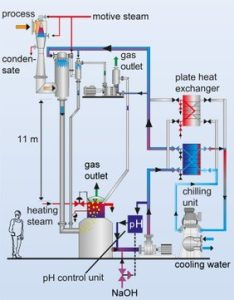Jet Vacuum Systems
Jet Vacuum Systems
Jet Vacuum Systems uses jet pumps/ejectors and condensers to create a vacuum for industrial applications. Utilizing the Venturi principle, process gases are efficiently extracted by a high-pressure motive media which, in an ejector, passes through a nozzle with a reduced cross-section to increase the velocity of the motive media, thus creating a negative pressure. These Jet Vacuum Systems offer cost-effectiveness, flexibility and reliability for various industries.
What is a Jet Vacuum System?
Jet vacuum systems are sophisticated empirical technical solutions that combine the use of Jet Vacuum Pumps / Ejectors and condensers to create vacuum in various industrial applications.
Jet Vacuum Pumps, Ejectors, utilize the Venturi principle, the reduction in pressure of a media as its velocity increases when passing through a smaller cross-section, to create effective negative pressure and handle process gases in various industrial applications. When the pressure energy of the motive medium passes a controlled reduction of a flow cross-section, a jet with very high velocity and kinetic energy is created and a corresponding negative pressure is created, according to the Venturi principle, which sucks in and mixes with the process medium on the suction side. The mixture passes through controlled outlet geometry, in the form of diffusers, to reduce the velocity and thus raise the outlet pressure to a pressure higher than the suction pressure, the process media is compressed, but lower than the pressure of the motive media.
Single Stage Vacuum Systems
Single-stage jet vacuum pumps achieve a maximum compression of 1:10, corresponding to a suction pressure from about 100 mBar absolute, vacuum, to an outlet pressure at atmospheric pressure. The design of the jet pump/ejector can be optimized to minimize steam consumption.
Multi-stage vacuum systems
If a deeper vacuum is required than what can be achieved with a single-stage jet vacuum ejector, several ejectors can be installed in series. To reduce energy consumption, condensers are also commonly used to condense steam and condensable gases. The earlier, at the lower temperature, the first condensation takes place, the lower the consumption of motive media and often also the total energy consumption. This phenomenon is utilized in so-called Alkaline Closed Loop (ACL-Cold) Vacuum Systems and ICE Condensation Vacuum Systems. In Multi-stage Vacuum Systems, Jet Vacuum Pumps, Ejectors and Condensers are often also combined with Liquid Ring Vacuum Pumps to further improve energy efficiency, Vacuum Systems with Liquid Ring Vacuum Pumps, so-called Hybrid Vacuum Systems.
Some examples of multi-stage vacuum system design for best adaptation to process conditions and minimum energy consumption or operating costs
- Vacuum systems with direct contact condensers
- Vacuum system with surface condensers
- Controllable vacuum systems
- Vacuum systems with liquid ring-Vacuum pumps
- Vacuum System with Alkaline Closed Loop (ACL-Cold)
- Process gas driven ejectors
- ICE Condensation Vacuum System
- Steam Jet Chiller Plants
Two-stage vacuum system
These cover a range of maximum compression at a ratio of 1:100, corresponding to a suction pressure from about 10 mBar absolute, vacuum, to an outlet pressure at atmospheric pressure. Since the design of the jet vacuum system should be optimized to minimize steam and energy consumption, it is usual to limit the compression over each ejector to a ratio of about 1:7. The temperature of the cooling water also affects the design of ejectors and their compression ratio to reduce energy consumption. Thus, the minimum effective suction pressure is also higher, about 20 mBar absolute (vacuum). Two-stage vacuum systems are usually used when suction pressure, vacuum, is in the range of 20-200 mBar absolute.
Three-stage vacuum system
Similarly to the two-stage vacuum system, the compression across each ejector is usually at a ratio of about 1:7. The temperature of the cooling water also affects the choice of ejectors and their compression ratio to reduce energy consumption. Thus, the minimum effective suction pressure is about 3.0 mBar absolute (Vacuum). Three-stage vacuum systems are usually used when you want to achieve suction pressure, vacuum, in the range of 10-100 mBar absolute.
Four-stage vacuum system
As above, it is desirable to limit energy consumption and hence compression in each ejector stage and the cooling water temperature in the condensers plays an important role in the design of these vacuum systems. The minimum effective suction pressure is about 0.5 mBar absolute (vacuum) for four-stage vacuum systems. Four-stage vacuum systems are most often used when suction pressure, vacuum, in the range of 1-10 mBar absolute is desired.
Five-stage vacuum system
As above, it is desirable to limit energy consumption and hence compression in each ejector stage and the cooling water temperature in the condensers plays an important role in the design of these vacuum systems. The minimum effective suction pressure is about 0.06 mBar absolute (vacuum) for five-stage vacuum systems. Five-stage vacuum systems are most often used when suction pressure, vacuum, in the range of 0.1-1 mBar absolute is desired.
Applications of the Jet Vacuum System
Jet vacuum systems are versatile and used in various industries, such as petrochemical, chemical, pharmaceutical, pulp & paper, food processing and wastewater treatment, etc. They can be used for processes involving filtration, evaporation, distillation, absorption, mixing, freeze-drying, drying, degassing, etc.
Jet vacuum systems are known for their efficiency, reliability and ability to handle a wide range of media types, pressures and temperatures. In many cases one jet pump/ejector is sufficient to achieve the desired process characteristics or vacuum for the process, so-called single-stage systems, in other cases and other process conditions there is a need to install several jet pumps/ejectors in series to achieve the desired output or vacuum, so-called multi-stage vacuum systems.
Some of the industries and sectors that often use Jet Vacuum System include:
- Biofuels and Edible Oils;
- Chemical industry;
- Food industry;
- Mining and steel industries;
- Petrochemical industry;
- Petroleum refineries;
- Thermal power plants;
- Paper and pulp industry;
Advantages of the Jet Vacuum System
Cost efficiency and low maintenance: A Jet Vacuum System is a relatively cost-effective solution compared to other vacuum technologies. Moreover, it requires minimal maintenance thanks to its simple design and lack of moving parts.
Flexibility and adaptability: Jet Vacuum Systems are highly flexible and can be tailored to meet different needs in different industries and applications. From the chemical industry to food production, these systems can be customized to suit specific requirements.
Efficiency and reliability: With the right design and installation, Jet Vacuum Systems are highly efficient and reliable in operation. They can deliver consistent vacuum to meet the requirements of different processes and applications.
High Operating Reliability: Steam ejectors can perform very well and create high-efficiency vacuum conditions even in very difficult operating conditions.
Wide range of construction materials: Steam ejectors can be made from virtually any material and therefore a specific corrosion- or erosion-resistant material can be chosen.



